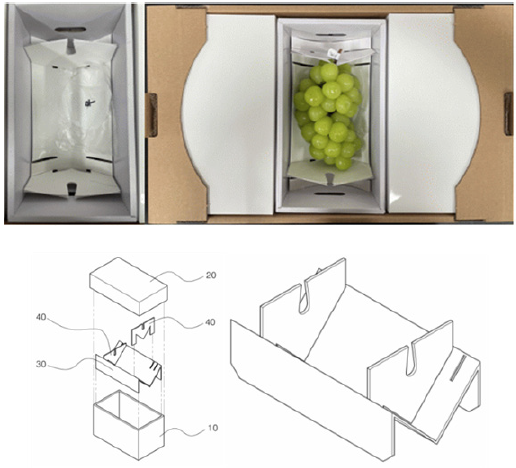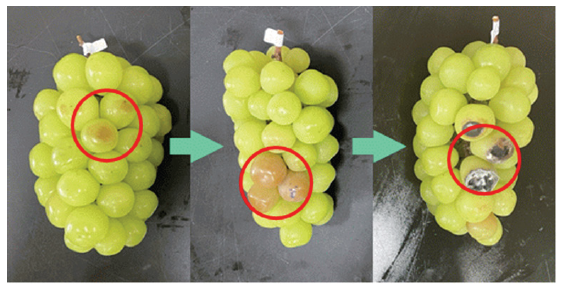Introduction
‘샤인머스켓’(Vitis labruscana Bailey × Vitis vinifera L.)은 대립으로 고당도, 저산도에 껍질 채 가식이 가능한 품종으로(Yamada et al., 2008) 최근 국내에서 선호도가 크게 증가하여 2021년 기준 전년대비 재배면적이 33% 증가하였다(KREI, 2021).
‘샤인머스켓’은 ‘거봉’ 등 대립계 포도에서 행해지는 gibberellic acid (GA3) 등을 이용한 무핵과 생산을 통해 부가 가치를 높일 수 있고 사이토키닌 활성물질인 우레아계 forchlorfenuron (CPPU) 혹은 페닐우레아계 thidiazuron (TDZ) 처리를 병행하면 과립비대를 증진할 수 있다(Reynolds et al., 1992; Kimura et al., 1996; Piao et al., 2003; Lee et al., 2013). 그러나, 최근 연구 결과, ‘샤인머스켓’ 포도에 대한 TDZ 처리는 과실의 주요 향기성분인 모노테르펜의 생합성을 억제하여 식미 및 향미에 영향을 줄 수 있다고 알려졌다(Wang et al., 2020).
한편, ‘샤인머스켓’에 대한 저장 전후 향기 및 품질관련 연구를 보면 생산과정 중 과방에 대한 적립처리(berry thinning)는 가장 주요한 향기성분인 모노테르펜 중 리날로올(이하 linalool) 함량을 증가시킨다고 보고(Choi et al., 2021)되었고, 저장 후 향기성분을 분석한 결과, 10℃에서 고유의 향기 및 그 주성분인 linalool 함량이 유지되므로 저온저장 후에는 반드시 승온을 동반하는 post-storage conditioning 처리가 필요하다고 보고된 바 있다(Matsumoto and Ikoma, 2016). 또한, 수확 후 상대습도를 달리하여 품질 변화를 조사한 결과, 과립의 경도 및 색차 변화보다는 낮은 습도환경에서 감모율 증가가 과실의 품질을 좌우하는 결정적 요인이었음을 보고된 바 있다(Watanabe et al., 2018). 더불어, 수출용 ‘샤인머스켓’ 수출 포장박스 내 유황패드, 에틸렌흡수제 및 알코올휘산제 처리는 과실의 탈립 및 부패 방지에 효과가 있다고 보고된 바 있다(Kim et al., 2021).
에센셜 오일은 포도를 비롯한 과수류의 수확 후 관리에 있어 친환경적 부패 방지제로서 합성 화학 물질의 대안으로 사용될 수 있는 물질로 떠오르고 있다(Taghavi et al., 2018). 로즈마리(Rosmarinus officinalis), 타임(Thymus vulgaris) 등에서 추출한 에센셜 오일의 처리가 일부 포도 품종에 있어 수확 후 부패를 줄이는 데 효과적이라고 보고되었고(Guillén et al., 2007; Abdolahi et al., 2010; Servili et al., 2017), 에센셜 오일의 주요 성분 중에서는 carvacrol, linalool 그리고 thymol은 포도의 Botrytis cinerea와 Penicillium digitatum 균사 성장 억제 및 곰팡이 감염 방지, 수확 후 품질 보존에 효과적이라고 보고된 바 있다(Marandi et al., 2010, 2011; Shin et al., 2014). 특히, 앞서 언급한 linalool은 ‘샤인머스켓’이 함유하고 있는 free 모노테르펜 중 60% 이상을 차지하며 ‘샤인머스켓’의 품질에 영향을 주는 주요한 성분으로 알려져 있다(Wang et al., 2020).
이에 본 연구에서는 ‘샤인머스켓’ 포도의 모의수출과정 중 품질보전을 위한 개별 포장박스 처리와 포장 내 rosemary와 thyme 오일 및 linalool 처리가 과실 품질 요인 변화에 미치는 영향을 구명하고자 실험을 실시하였다.
Materials and Methods
과실 재료는 2021년 10월 05일 경북 영천시 금호읍 봉죽리 개인농장(신길호)에서 ‘샤인머스켓’ 포도를 구매하여 충남대학교 과수원예학 실험실로 운송 후, 1일 간 상온에서 방치한 후 실험에 이용하였다. 처리구는 대조구, 2종의 에센셜 오일 즉, 로즈마리 오일(이하 rosemary; rosemary oil, Kanta Enterprises Pvt. Ltd., Noida, India)과 타임 오일(이하 thyme; white thyme oil, Kanta Enterprises Pvt. Ltd., Noida, India), 그리고 ‘샤인머스켓’의 주요 향기성분인 리날로올(이하 linalool; linalool 97%, Alfa Aesar, Ward Hill, Massachusetts, USA) 등 4가지 처리구를 두었다. 사용된 에센셜 오일의 화학적 조성은 Table 1과 같다. 처리 방법은 지름 110 mm의 여과지(Advantec No. 6 110 mm, Toyo Roshi Kaisha Ltd., Tokyo, Japan)를 1 mL의 증류수로 적신 후 각 처리 물질을 125 μL을 첨가하였고 대조구는 동량의 증류수를 첨가하였다. 이를 과실에 직접 닿는 것을 방지하기 위해 한쪽면이 개봉된 비닐(HDPE, 0.02 mm, Cleanwrap, Seoul, Korea) 안에 넣고 개별 종이 포장 박스 바닥면의 V홈에 넣고 과실을 올려 뚜껑을 덮었다(Fig. 1). 에센셜 오일의 박스 내 최대 축적 농도는 31.25 ppm 정도로 처리하였으며 모의수출수송기간(1℃, 3주) 동안 자연 휘산되게 두었다. 처리당 8박스씩 반복하였으며 이를 모의수출수송기간(1℃, 3주)을 부여한 후 25℃의 상온에서 14일간 모의유통기간을 거쳐 과실의 품질 요인을 분석하였다.
품질조사는 모의유통기간 7, 14일 경과 후 두 번 실시하였으며 과방중은 전자저울(CB-3000, AND, Seoul, Korea)로 측정하였다. 과립의 경도는 물성측정기(TMS-Pro, Food Technology Corp., Philadelphia, USA)를 이용하여 처리당 과립 30개씩 측정하였으며, 직경 5 mm 측정봉을 5 mm sample move, 100 mm·min-1의 조건으로 적도면에 수직으로 가해지는 최대압력을 측정하였다. 가용성 고형물은 과립 10개를 모아 cheesecloth를 이용하여 착즙한 후 digital refractometer (PR-32a, ATAGO, Tokyo, Japan)를 사용하여 측정하였다. 산 함량은 동일한 방법으로 착즙한 과즙 5 mL를 증류수 35 mL에 희석하여 0.1 N NaOH를 이용하여 pH 8.3까지 중화 적정한 후 주석산으로 환산하였다.
탈립 및 부패는 조사 시기별 9개의 과방을 대상으로 1과방당 탈립 및 부패 과립의 숫자를 전체 과립수로 나누어 백분율로 표기하였다. 아로마 장해와 전체과방 중 건전 과립의 비율도 동일하게 조사하였다. 과경의 갈변도 및 곰팡이 발생도는 육안으로 전체 과경에 대한 갈변 면적 및 곰팡이 발생면적을 5단계 지수로 표기하였다. 지수 1은 전체 과경 갈변의 면적이 0 - 10%, 지수 2는 11 - 30%, 지수 3은 31 - 60%, 지수 4는 61 - 80%, 지수 5는 81% 이상으로 판정하였다.
과피색 측정에는 chroma meter (CR-410, Minolta, Osaka, Japan)를 이용하여 처리당 과립 30개씩 과립의 적도면을 측정하였으며, L* (lightness), a* (redness), b* (yellowness)를 구하고 Hue angle을 계산하였다.
통계 분석은 SPSS 프로그램(Ver. 26, SPSS, Inc., Chicago, Illinoise, USA)을 사용하였다. 분산분석(ANOVA)은 p < 0.05의 유의수준에서 실행되었으며, 평균은 Duncan’s multiple range test로 차이를 검정하였다.
Results and Discussion
과방의 감모율은 모의 유통기간이 경과함에 따라 증가하여 유통기간 14일에 10% 이상으로 조사되었으며 처리구간 유의한 차이는 보이지 않았다(Table 2). 이는 에센셜 오일의 처리로 저장 중 과실의 감모를 억제하였다는 보고(Marandi et al., 2011)와는 다른 것이었는데 포도의 품종 차이, 처리농도 및 사용된 패키징의 차이에 기인한 것으로 판단된다. 즉, 에센셜 오일과 카복시메틸셀룰로스 필름의 혼합처리에 대한 특성을 검증한 이전 논문에서 에센셜 오일의 단독처리는 대조구보다 감모을 억제하는데 효과가 크지 않았지만 카복시메틸셀룰로스 필름과 혼합처리한 경우에는 감모 억제에 효과를 보여 좋은 상호 작용을 나타냈다(Mei et al., 2021). 본연구에서는 친환경적 포장 방법을 연구하기 위해 플라스틱필름 포장 없이 종이 박스만을 사용하였으므로 종이의 특성 상 흡습으로 인해 감모가 늘어난 것으로 판단되므로 에센셜 오일의 효과를 증진시키기 위해서는 필름포장이 부수적으로 필요할 것으로 판단되었다.
과립의 경도를 조사한 결과, 모의 유통기간이 경과함에 따라 경도가 하락한 것으로 나타났는데 에센셜 오일 및 linalool 처리구는 모의 유통 7일까지는 대조구와 비교하여 통계적 유의차를 보이지 않았다. 가용성고형물 모의 유통기간이 경과함에 따라 다소 증가하고 산함량은 다소 감소하는 경향을 보였으나 처리 간 통계적으로 유의한 차이는 없었다. 당산비는 모의 유통기간이 경과함에 따라 다소 증가하는 경향을 보였다. 모의 유통기간 7일차 조사에서는 대조구에 비해 처리구가 다소 낮았으나 14일차부터 대조구에 비해 다소 높은 경향을 보였다.
상온유통 기간 중의 과립의 탈립률은 기간이 경과함에 따라 증가하는 경향을 보여 대조구에서는 14일차에 51.9%의 탈립률을 보여 가장 높았던 반면, linalool 처리의 경우 유통 7일차 및 14일차에 각각 5.0 및 21.9%가 탈립되었고, rosemary 오일 처리구는 12.5%로 처리구 내에서는 가장 낮았으며 thyme 오일 처리구는 유통 7일차에는 19.9%, 14일차에는 42.5%가 탈립되어 탈립 억제 효과가 가장 떨어졌다(Table 3). 탈립 증상은 과립의 수분상실에 따른 과립경과 과립의 분리를 의미하므로 탈립률을 낮추기 위해서는 감모를 줄이기 위한 증산량 경감 조치가 필요한데(Crisosto et al., 2001), 본 실험에 사용된 종이박스의 물리적 특성으로 인해 유기된 감모율 증가는 과립의 탈립을 조장한 것으로 판단되므로 추후 상대습도 유지를 위한 필름의 병행사용이 추천되었다.
과립의 부패는 모의 유통 7일차에는 thyme 오일 처리구의 0.44%를 제외하고 부패되지 않았으며 유통 14일차에는 처리 간 통계적 유의차는 없었으나 대조구가 12.1%로 나타나 rosemary 오일 처리구의 5.4%, thyme 오일 처리구의 9.4%, linalool 처리구의 10.9%에 비해 다소 높은 부패율을 보였다(Table 3).
한편, ‘샤인머스켓’ 포도의 과피에서 특이적인 변색이 관찰되었는데 이는 에센셜 오일 처리구에서만 발생하였으며 처리 disk가 직접 닿는 부위에서만 발생하였다. 모의 유통기간이 길어짐에 따라 그 정도는 심했고 갈색으로 변색되거나 심하면 그 부위가 검은 반점형태로 변했다(Fig. 2). 이를 아로마 장해로 보고 발생률을 조사하였는데 linalool 처리구는 유의하게 낮았던 반면 thyme 처리구에서 큰 발생률을 보였다(Table 3). 이것이 다른 처리구에 비해 thyme 처리구에서 부패율이 높았던 원인으로 판단된다.
비건전과립을 제외한 건전과립의 비율을 조사한 결과, 모의 유통기간 14일차에 대조구 35.6%에 비해 rosemary 오일 및 linalool 처리구에서 각각 72.2, 61.8%로 조사되어 통계적으로 유의한 차이를 보이며 비건전과립의 발생을 억제하는데 효과를 보였다(Table 3).
과경의 갈변 및 곰팡이 발생 지수를 조사한 결과, 과경의 갈변은 모의 유통기간 7일차부터 4.6 이상의 발생 지수를 보여 억제하는데 큰 효과가 없었고 이로 인해 탈립 발생률이 높았던 것으로 판단된다. 과경의 곰팡이 발생 지수는 모의 유통기간이 증가함에 따라 다소 증가하는 경향을 보였고 유통 7일차 조사에서 대조구에 비해 에센셜 오일 처리구가 다소 효과를 보였지만 통계적으로 유의한 차이는 없었다(Table 4).
과피의 색변화를 조사한 결과, 명도를 나타내는 L*은 저장 전 44.3으로 조사되었는데 모의 유통기간이 경과함에 따라 다소 감소하는 경향을 보였으나 처리간 유의한 차이는 나타나지 않았다. 적색도를 나타내는 a*는 저장 전 -5.9로 조사되었는데 모의 유통기간이 경과함에 따라 다소 증가하여 ‘샤인머스켓’의 고유의 색인 청색도가 다소 감소하는 경향을 보였으며 황색도(b*)는 유통기간 경과에 따라 다소간 감소하는 경향을 보이는 등 전체적으로 과피의 색변화에 있어 일정한 경향성은 조사되지 않아(Table 5), 에센셜 오일의 처리는 과피색 변화에는 큰 영향은 미치지 않는 것으로 판단된다.
이상의 결과를 종합하여 볼 때, ‘샤인머스켓’ 포도에 rosemary오일을 처리할 경우, 감모율 및 과립의 경도, 가용성 고형물 함량, 산도, 당산비, 색변화 등 품질유지에는 큰 영향을 미치지 않았지만 탈립률 저감에 효과를 보였다. 또한, rosemary 처리구는 비건전과립 발생 억제에도 효과를 보여 수출용 포도 코팅재료로 사용될 수 있는 가능성을 확인하였다. 한편, 앞선 연구에서 ‘Tabarzeh’ 포도의 Borytis cinerea 균사체 성장 억제 및 부패방지 효과를 보이며 감모, 과방 및 과경의 갈변을 줄이는 등 과실 품질 유지에 효과를 보였던 thyme 오일 처리(200 - 600 μL·L-1)는 ‘샤인머스켓’ 포도에는 큰 효과가 없는 것으로 조사되었는데 이는 포도의 품종 및 에센셜 오일 처리 농도의 차이인 것으로 판단된다(Abdolahi et al., 2010). 한편, 본 실험에서 나타난 과립의 무름장해는 관행적으로 포도 부패방지를 위해 사용되는 이산화황 패드의 고농도 장해(Gao et al., 2003)와 유사한 것으로 보여지는데, 에센셜 오일을 고농도로 처리할수록 부패방지 효과가 떨어진다는 이전의 연구 결과(Mei et al., 2021)가 원인일 가능성도 있다고 생각되며 추후 ‘샤인머스켓’ 품종에 대한 적정 농도 및 처리방법에 대한 추가적인 연구를 수행해야만 할 것으로 판단된다.











